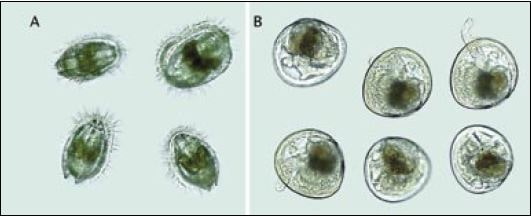5.4 SETTLEMENT AND METAMORPHOSIS
5.4.1 Introduction
Larvae swim freely in the water column for much of the larval phase (Figure 83A). Typically, they will swim upwards to the water surface and then retract the swimming/ feeding organ (the velum), close their shell valves and sink towards the bottom to resume swimming activity again.
As they develop towards the end of the larval phase, feeding activity slows, less food is consumed, and larvae spend an increasing period of time towards the bottom and on the bottom of the tank. This marks the beginning of metamorphosis, a critical stage in development during which extensive mortalities can occur. Considerable anatomical changes take place during metamorphosis. Successful transformation and survival to the juvenile form is dependent on a number of factors, not least of which is the availability of energy reserves accumulated during the larval phase.
The importance of producing healthy larvae with large energy reserves cannot be over stressed.

Figure 83: Photomicrographs of (A) swimming Argopecten gibbus larvae showing the ciliated swimming/feeding organ, the velum, and (B) eyed pediveligers of the same species. The foot can be seen extending between the shell valves in three larvae and the small, black eye-spot is visible below the digestive gland, particularly clear in the upper left larva in (B).
Metamorphosis can be divided into two stages, settlement which is reversible (except in oysters) and metamorphosis which is irreversible.
Settlement is the initial stage of metamorphosis. Larvae begin to drop out of the water column onto a substrate, crawl around on the substrate using their foot with the shell upright and search the surface for a suitable place to settle (Figure 83). If the surface is unsuitable they will move off or swim away and seek a more suitable location. This process can be repeated several times and metamorphosis can be delayed for some time if a suitable surface is not found.
Metamorphosis is the second stage and it is irreversible. Factors that trigger it remain unknown but type of substrate along with physical, chemical and biological cues are undoubtedly important. Considerable morphological and physiological changes occur in the animal at this time as it changes from a swimming larva to a spat. Metamorphosis can occur quickly but can be delayed if suitable conditions are not met. In hatcheries it can sometimes be delayed if water temperature is reduced.